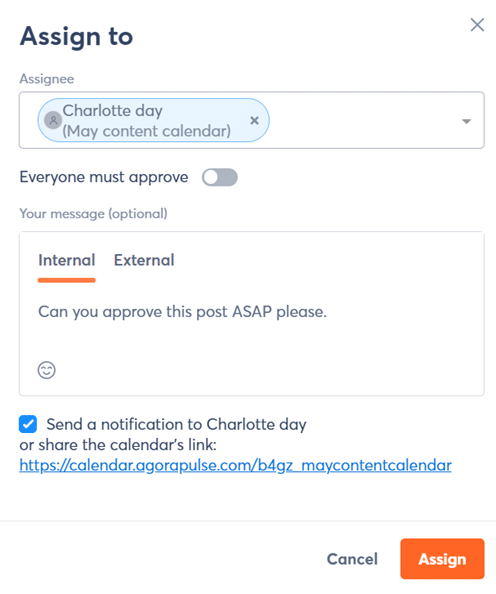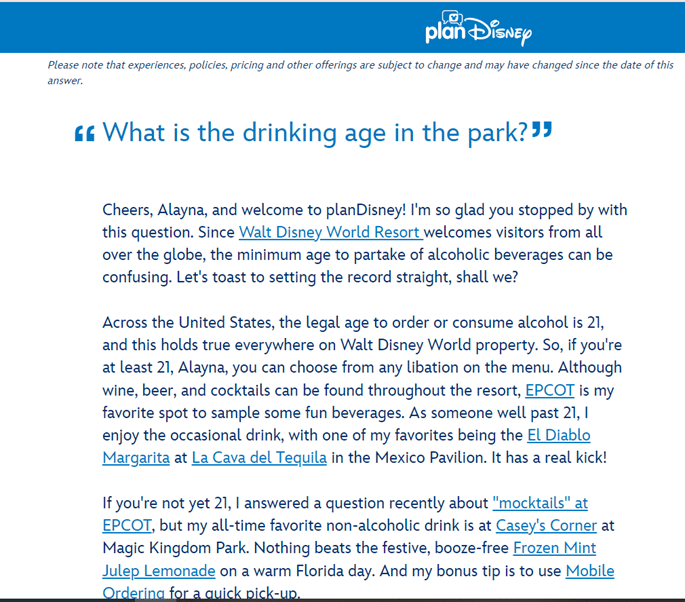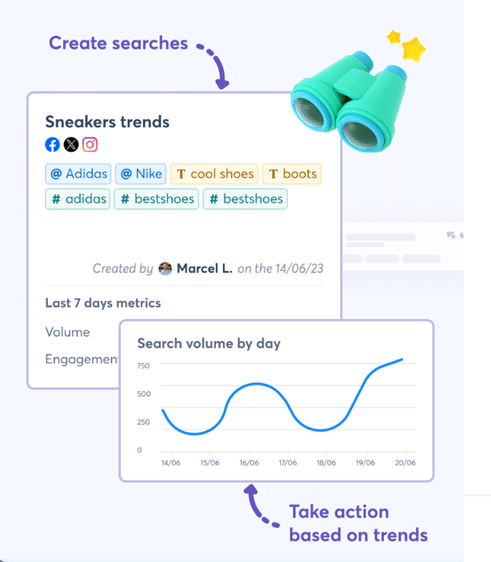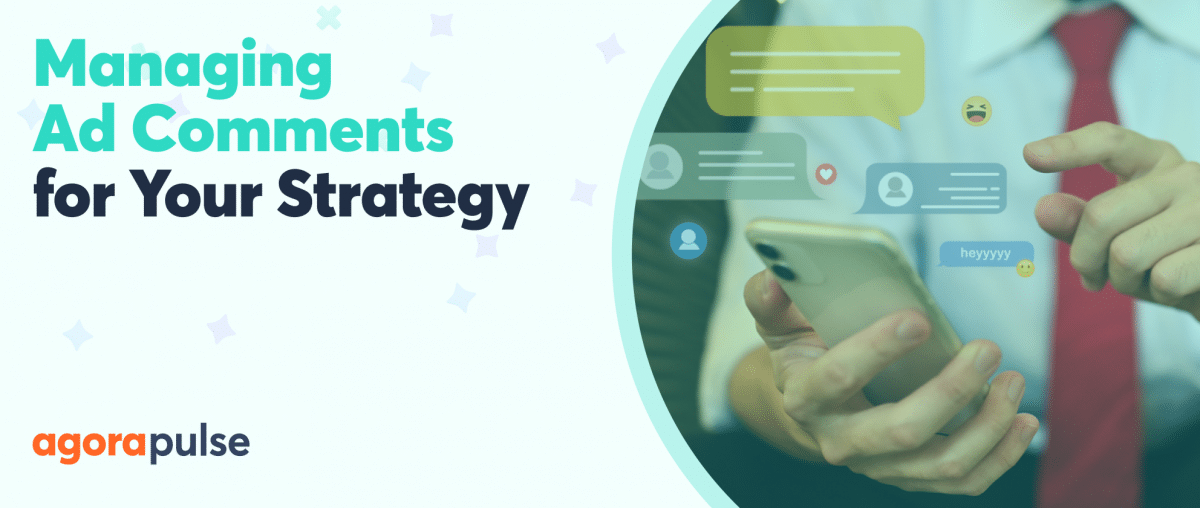Brands are often taken by surprise when a social media crisis happens. But social media crises often brew quietly before they explode into something major. Fortunately, you can detect them at an earlier stage than you perhaps realize.
Let’s look at how to spot the signs of an incoming social media crisis. You can also sign up for a free trial of Agorapulse now and keep an eye on your socials.
Five Signs of a Social Media Crisis
As director of a financial content marketing agency, I’ve overseen plenty of crisis situations—from financial regulation breeches to client lawsuits right through to the more bizarre. Like the one where a company founder was caught doing X with Y at Z!
One thing’s for sure: Brands will always face social media crises, and social media managers will always be left to manage them.
Here are 5 signs that danger is looming for your brand.
1. Negative mentions spike
We love to get tons of engagement on our brand accounts, but what if it isn’t positive engagement? A spike in negative mentions, comments, or messages could signal major trouble for your brand. And a social media crisis can very quickly become a pile-on.
Algorithms prioritize trending content, so users can see what others have commented on, and hashtags start to go viral.
Do this and avert that social media crisis:
Implement consistent social media listening to track brand mentions, comments, and sentiment across your channels.

By doing this on Agorapulse’s intuitive listening dashboard, I can identify shifts in sentiment and detect potential issues early on.
Of course, knowing there is a crisis brewing won’t in itself stop the crisis from happening.
But early detection of a social media crisis can buy you some time to confer with stakeholders and formulate appropriate responses or a proactive statement.

Example of social media monitoring
2. Customer complaints escalate
A sudden surge in customer complaints related to a specific issue or product could indicate a potential crisis brewing. If you’re getting your social media notifications in real-time via an app, then you can gauge an increase in complaints.
Complaints might also pour in through other channels, such as your customer support chat or email. It’s important to communicate internally.
Here’s the exciting thing: You can turn a bad situation into a brand win if you act fast enough! Check out the example below.
Remember when:
In April 2024, Jennifer Jensen purchased a North Face waterproof rain jacket. But when the rain began in the middle of her hike, she discovered that her jacket wasn’t waterproof at all. She made a TikTok and stated that her intent wasn’t to seek a refund. Instead, she had a unique request for the brand. “Redesign this raincoat to make it waterproof and express deliver it up to the top of Hooker Valley Lake in New Zealand where I will be waiting.”
The complaint video quickly went viral, reaching over 11.6 million views and numerous comments. All could have been lost for North Face.
But the brand responded with an epic marketing video where they retrieved a red waterproof jacket from a local store in New Zealand. The video showcased the employee boarding a helicopter to meet Jensen and deliver her new jacket.
Beyond cool. Goosebumps!
This post garnered over 4 million views and thousands of comments, including a delighted response from Jensen: “You guys definitely came through for me. We’ll give the new jacket a shot on my next rainy day hike.”
This incredible response would not have been possible without monitoring customer complaints and any escalating mentions on TikTok.
Social media crisis tip:
With Agorapulse, you can quickly assign posts and responses to another member of your team or the brand if you’re their social media agency.

Assign approval of social media content
3. Misinformation spreads
Social media is a hotbed of misinformation and fake news. And it’s not just the small players doing it either. Major TV networks, celebrities, and influencers have been known to spread misinformation. Once that misinformation freight train goes viral, it can be hard to stop it.
Here are just a few of the misinformation examples I’ve witnessed:
- Rumors of a takeover or company bankruptcy significantly impact shareholder and consumer confidence.
- False accusations stir about your products, denting sales.
- Fake negative reviews spammed by competitors, disgruntled employees, or angry customers
- Competitor sabotage is where companies spread false information about competing products or services to gain a competitive advantage. (I’ve seen this before with false claims about a product’s safety.)
- Fake pages or individuals impersonate your company on social media for nefarious purposes.
- The deliberate skew of a product or company values to rage bait for engagement
Remember when:
In August 2022, a TikTok video was uploaded, claiming that Disney World was going to lower the drinking age to 18. The TikTok video acquired millions of views in just a couple of days, provoking outrage, social media hostility, and numerous viral hashtags. This story was also shared by ABC 10 News.
But the whole thing was fiction. The article came from The Mouse Trap blog, a satirical site specializing in fake stories about Disney parks.
Disney quickly quashed those rumors though and updated its social media, blog, FAQs, and content to clarify this. Remember that staying silent isn’t usually a good strategy. Monitoring misinformation surrounding your brand and addressing it quickly is a better way to go!

Example of how to address a social media crisis
4. Employee discontent
We talk a lot about employee advocacy here at Agorapulse because employees can make or break a brand on social media. Positive employee testimonials, putting happy faces to your brand, and employees sharing your brand updates are the stuff of dreams.
But on the other side of the coin can be unhappy, discontented employees who could wreak havoc.
Internal issues increasingly spill over onto social media. And with an eager audience on TikTok waiting for people to spill that corporate tea, a social media crisis can easily be triggered.
Employee dismissals, workplace malpractice, and pay disputes can all go very viral.
Avert that crisis by doing this:
You can prevent most employee social media crises simply by treating people nicely, communicating properly, and paying fairly. But social media managers don’t usually have control over these matters. All they can do is avert the impending social media crisis.
Remember when:
In January 2024, Brittany Pietsch, an employee of the cloud security company Cloudflare, posted a TikTok video of herself being terminated. It garnered millions of views on X and TikTok and sparked debate around termination etiquette. By the time my European self had hit TikTok, this was already well and truly viral with #cloudflare and #cloudflarelayoff trending heavily. The video was difficult to watch, so it prompted a visceral reaction in viewers.
Cloudflare took a long time to respond to the video. When they did, the CEO played down layoffs and aimed to minimize the damage and also add some misjudged sentiment:
Sometimes underperforming employees don’t actually listen to the feedback they’ve gotten before we let them go. Importantly, just because we fire someone doesn’t mean they’re a bad employee.
The lack of monitoring and misjudged response enabled thousands of TikTok Duets, commentators, and media sites to weigh in with their opinions, escalating and extending the social media crisis.
The first day after the discovery of a PR crisis is of paramount importance. What a company does during this time, whether setting the record straight, issuing an apology, or fixing the situation, can determine its future.
5. Watching a competitor crisis
Paying attention to industry trends is key to developing future policies and products in addition to helping you avoid a social media crisis. But did you know that an incoming social media crisis might happen to your competitor before it happens to you? That’s good … right?
Yes—if you are paying attention and moving quickly!
Here are some instances where I’ve seen this happen:
- Your financial services competitor runs a non-compliant campaign and just got busted by a regional regulator. This allows you to check your campaigns and ensure you weren’t misstepping too!
- Your competitor launches a new product, news release, or campaign but the audience reaction is terrible. We’re not here to gloat over their mistakes, but we are here to learn from them. Their audience could be your potential audience so watching their reactions is marketing gold dust.
- Your competitor closes an office or product range. Should you swoop in and start targeting those customers? Possibly yes. Following their moves on social media can give you valuable intel.
Avert that crisis by doing this:
It wasn’t your crisis, but by setting up competitor alerts, you can reap the rewards for your own brand.

Create listening searches in the Agorapulse social media management tool
Set up replies in your Agorapulse dashboard, so you can instantly reply to relevant questions or hashtags.

Screenshot of how to create a saved reply in the Agorapulse social media management tool
If you want a helpful, fast walkthrough, check out this video by Agorapulse product marketing manager Jacob:

Social media crises, if left unchecked, can seriously damage brands.
Let me leave you with an important statistic to remember: The Public Relations Society of America reported that organizations reacting to a crisis within the first hour are 85% more likely to maintain public confidence.
Are you using social media listening to spot an incoming social media crisis? Read more about social media listening here and then check out Agorapulse for yourself for free.











